HLT54115 Diploma of Nursing: Anatomy and Physiology Written Assessment
VerifiedAdded on 2021/10/19
|23
|2816
|214
Homework Assignment
AI Summary
This nursing assignment analyzes and responds to client health information, focusing on the anatomy and physiology of various human body systems, including cells and tissues, integumentary, musculoskeletal, nervous, endocrine and senses, cardiovascular, respiratory, urinary, lymphatic, immune, gastrointestinal, and reproductive systems. For each system, the assignment explores the anatomy, physiology, and provides a pictorial representation. It examines the interrelation with other systems, lists two diseases (pathophysiology) and their impact, two medications with contraindications, and discusses how the system defends itself and its immune responses. The assignment also covers signs of aging, types of trauma, and suggests nursing interventions and planning services for client care related to the chosen diseases. The document provides detailed information on each body system, including common diseases, medications, and nursing considerations, demonstrating a thorough understanding of human anatomy and physiology relevant to nursing practice. The assignment references various sources to support the information provided.
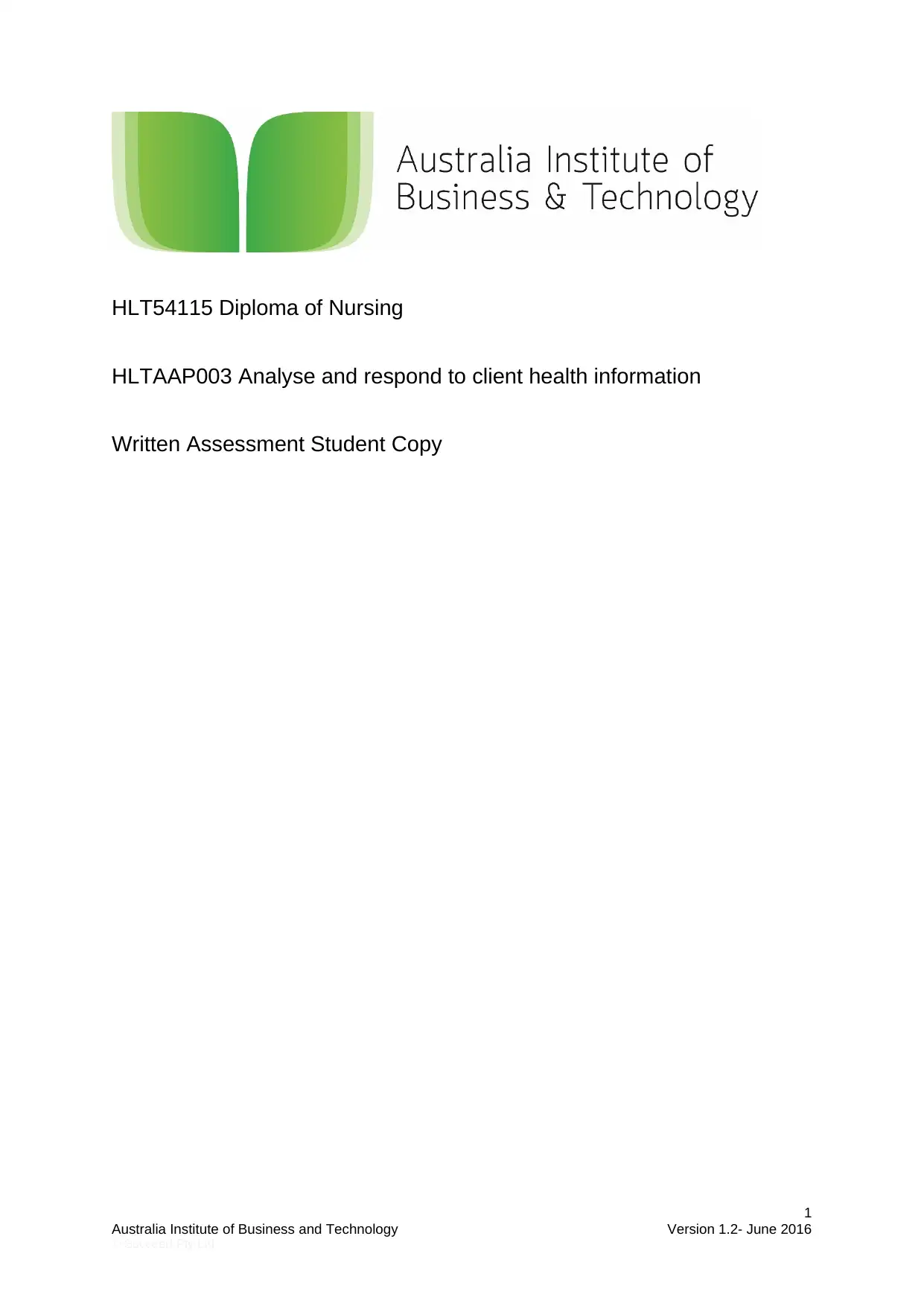
HLT54115 Diploma of Nursing
HLTAAP003 Analyse and respond to client health information
Written Assessment Student Copy
1
Australia Institute of Business and Technology Version 1.2- June 2016
© Succeed Pty Ltd
HLTAAP003 Analyse and respond to client health information
Written Assessment Student Copy
1
Australia Institute of Business and Technology Version 1.2- June 2016
© Succeed Pty Ltd
Paraphrase This Document
Need a fresh take? Get an instant paraphrase of this document with our AI Paraphraser
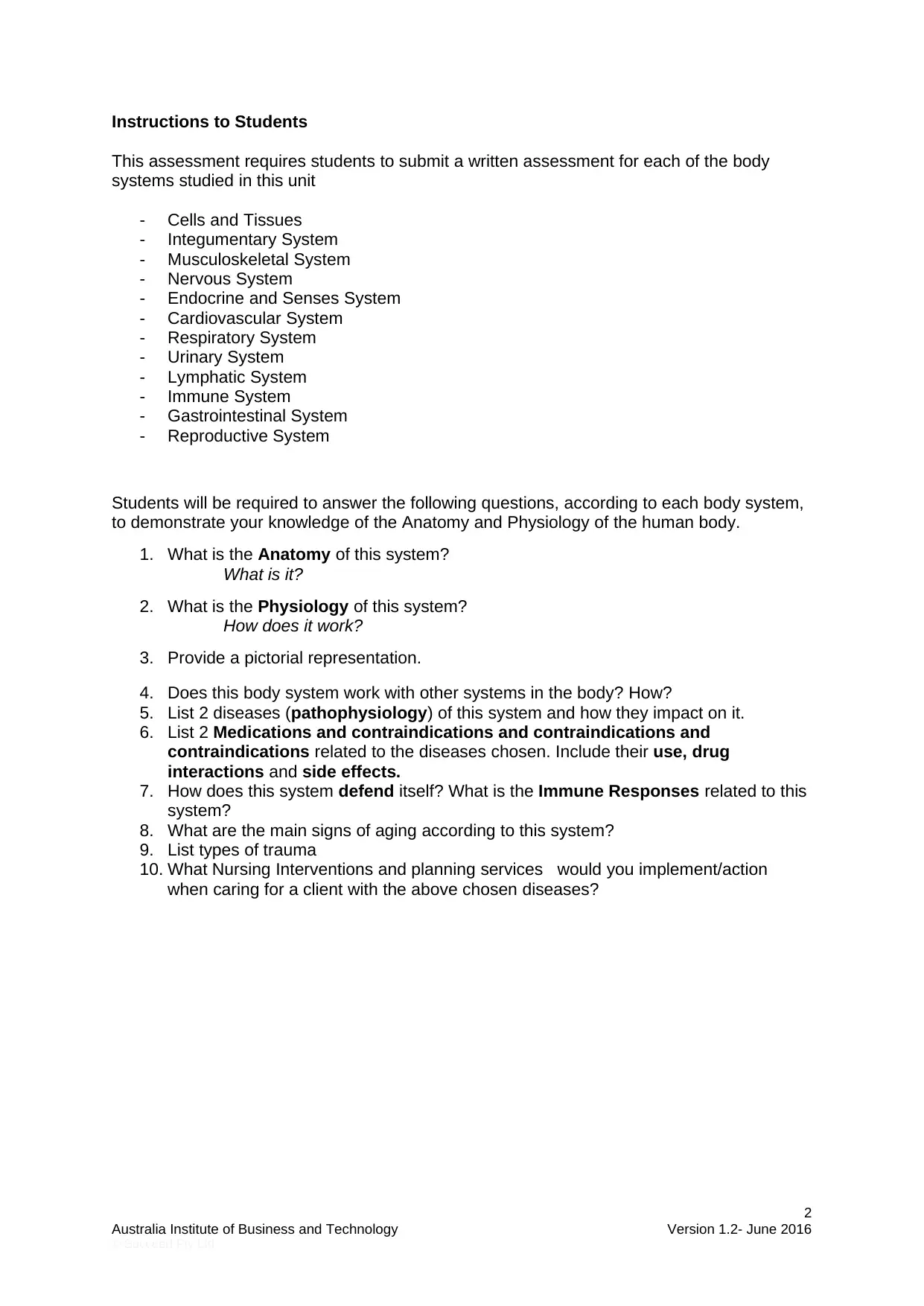
Instructions to Students
This assessment requires students to submit a written assessment for each of the body
systems studied in this unit
- Cells and Tissues
- Integumentary System
- Musculoskeletal System
- Nervous System
- Endocrine and Senses System
- Cardiovascular System
- Respiratory System
- Urinary System
- Lymphatic System
- Immune System
- Gastrointestinal System
- Reproductive System
Students will be required to answer the following questions, according to each body system,
to demonstrate your knowledge of the Anatomy and Physiology of the human body.
1. What is the Anatomy of this system?
What is it?
2. What is the Physiology of this system?
How does it work?
3. Provide a pictorial representation.
4. Does this body system work with other systems in the body? How?
5. List 2 diseases (pathophysiology) of this system and how they impact on it.
6. List 2 Medications and contraindications and contraindications and
contraindications related to the diseases chosen. Include their use, drug
interactions and side effects.
7. How does this system defend itself? What is the Immune Responses related to this
system?
8. What are the main signs of aging according to this system?
9. List types of trauma
10. What Nursing Interventions and planning services would you implement/action
when caring for a client with the above chosen diseases?
2
Australia Institute of Business and Technology Version 1.2- June 2016
© Succeed Pty Ltd
This assessment requires students to submit a written assessment for each of the body
systems studied in this unit
- Cells and Tissues
- Integumentary System
- Musculoskeletal System
- Nervous System
- Endocrine and Senses System
- Cardiovascular System
- Respiratory System
- Urinary System
- Lymphatic System
- Immune System
- Gastrointestinal System
- Reproductive System
Students will be required to answer the following questions, according to each body system,
to demonstrate your knowledge of the Anatomy and Physiology of the human body.
1. What is the Anatomy of this system?
What is it?
2. What is the Physiology of this system?
How does it work?
3. Provide a pictorial representation.
4. Does this body system work with other systems in the body? How?
5. List 2 diseases (pathophysiology) of this system and how they impact on it.
6. List 2 Medications and contraindications and contraindications and
contraindications related to the diseases chosen. Include their use, drug
interactions and side effects.
7. How does this system defend itself? What is the Immune Responses related to this
system?
8. What are the main signs of aging according to this system?
9. List types of trauma
10. What Nursing Interventions and planning services would you implement/action
when caring for a client with the above chosen diseases?
2
Australia Institute of Business and Technology Version 1.2- June 2016
© Succeed Pty Ltd
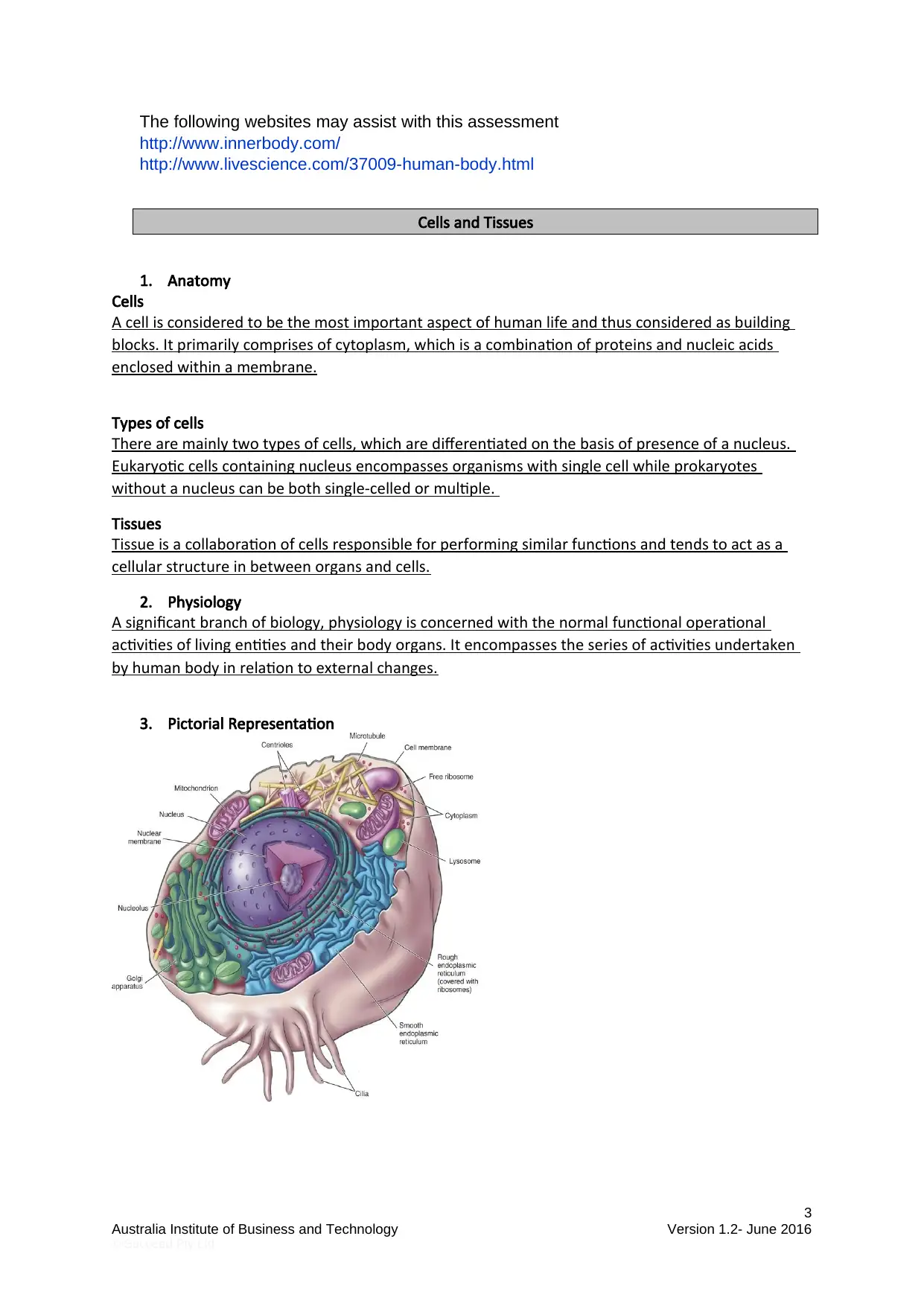
The following websites may assist with this assessment
http://www.innerbody.com/
http://www.livescience.com/37009-human-body.html
Cells and Tissues
1. Anatomy
Cells
A cell is considered to be the most important aspect of human life and thus considered as building
blocks. It primarily comprises of cytoplasm, which is a combination of proteins and nucleic acids
enclosed within a membrane.
Types of cells
There are mainly two types of cells, which are differentiated on the basis of presence of a nucleus.
Eukaryotic cells containing nucleus encompasses organisms with single cell while prokaryotes
without a nucleus can be both single-celled or multiple.
Tissues
Tissue is a collaboration of cells responsible for performing similar functions and tends to act as a
cellular structure in between organs and cells.
2. Physiology
A significant branch of biology, physiology is concerned with the normal functional operational
activities of living entities and their body organs. It encompasses the series of activities undertaken
by human body in relation to external changes.
3. Pictorial Representation
3
Australia Institute of Business and Technology Version 1.2- June 2016
© Succeed Pty Ltd
http://www.innerbody.com/
http://www.livescience.com/37009-human-body.html
Cells and Tissues
1. Anatomy
Cells
A cell is considered to be the most important aspect of human life and thus considered as building
blocks. It primarily comprises of cytoplasm, which is a combination of proteins and nucleic acids
enclosed within a membrane.
Types of cells
There are mainly two types of cells, which are differentiated on the basis of presence of a nucleus.
Eukaryotic cells containing nucleus encompasses organisms with single cell while prokaryotes
without a nucleus can be both single-celled or multiple.
Tissues
Tissue is a collaboration of cells responsible for performing similar functions and tends to act as a
cellular structure in between organs and cells.
2. Physiology
A significant branch of biology, physiology is concerned with the normal functional operational
activities of living entities and their body organs. It encompasses the series of activities undertaken
by human body in relation to external changes.
3. Pictorial Representation
3
Australia Institute of Business and Technology Version 1.2- June 2016
© Succeed Pty Ltd
⊘ This is a preview!⊘
Do you want full access?
Subscribe today to unlock all pages.

Trusted by 1+ million students worldwide
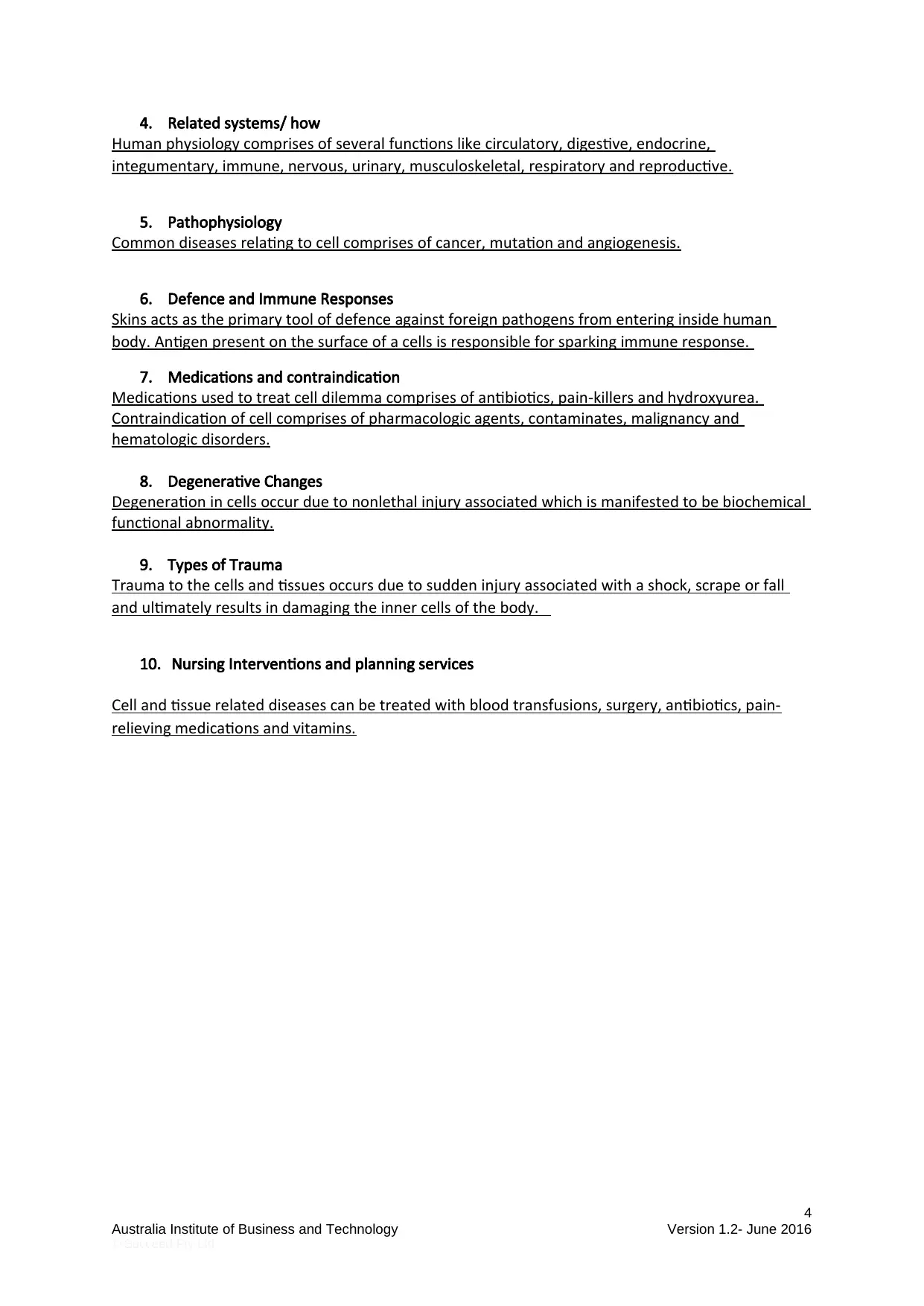
4. Related systems/ how
Human physiology comprises of several functions like circulatory, digestive, endocrine,
integumentary, immune, nervous, urinary, musculoskeletal, respiratory and reproductive.
5. Pathophysiology
Common diseases relating to cell comprises of cancer, mutation and angiogenesis.
6. Defence and Immune Responses
Skins acts as the primary tool of defence against foreign pathogens from entering inside human
body. Antigen present on the surface of a cells is responsible for sparking immune response.
7. Medications and contraindication
Medications used to treat cell dilemma comprises of antibiotics, pain-killers and hydroxyurea.
Contraindication of cell comprises of pharmacologic agents, contaminates, malignancy and
hematologic disorders.
8. Degenerative Changes
Degeneration in cells occur due to nonlethal injury associated which is manifested to be biochemical
functional abnormality.
9. Types of Trauma
Trauma to the cells and tissues occurs due to sudden injury associated with a shock, scrape or fall
and ultimately results in damaging the inner cells of the body.
10. Nursing Interventions and planning services
Cell and tissue related diseases can be treated with blood transfusions, surgery, antibiotics, pain-
relieving medications and vitamins.
4
Australia Institute of Business and Technology Version 1.2- June 2016
© Succeed Pty Ltd
Human physiology comprises of several functions like circulatory, digestive, endocrine,
integumentary, immune, nervous, urinary, musculoskeletal, respiratory and reproductive.
5. Pathophysiology
Common diseases relating to cell comprises of cancer, mutation and angiogenesis.
6. Defence and Immune Responses
Skins acts as the primary tool of defence against foreign pathogens from entering inside human
body. Antigen present on the surface of a cells is responsible for sparking immune response.
7. Medications and contraindication
Medications used to treat cell dilemma comprises of antibiotics, pain-killers and hydroxyurea.
Contraindication of cell comprises of pharmacologic agents, contaminates, malignancy and
hematologic disorders.
8. Degenerative Changes
Degeneration in cells occur due to nonlethal injury associated which is manifested to be biochemical
functional abnormality.
9. Types of Trauma
Trauma to the cells and tissues occurs due to sudden injury associated with a shock, scrape or fall
and ultimately results in damaging the inner cells of the body.
10. Nursing Interventions and planning services
Cell and tissue related diseases can be treated with blood transfusions, surgery, antibiotics, pain-
relieving medications and vitamins.
4
Australia Institute of Business and Technology Version 1.2- June 2016
© Succeed Pty Ltd
Paraphrase This Document
Need a fresh take? Get an instant paraphrase of this document with our AI Paraphraser
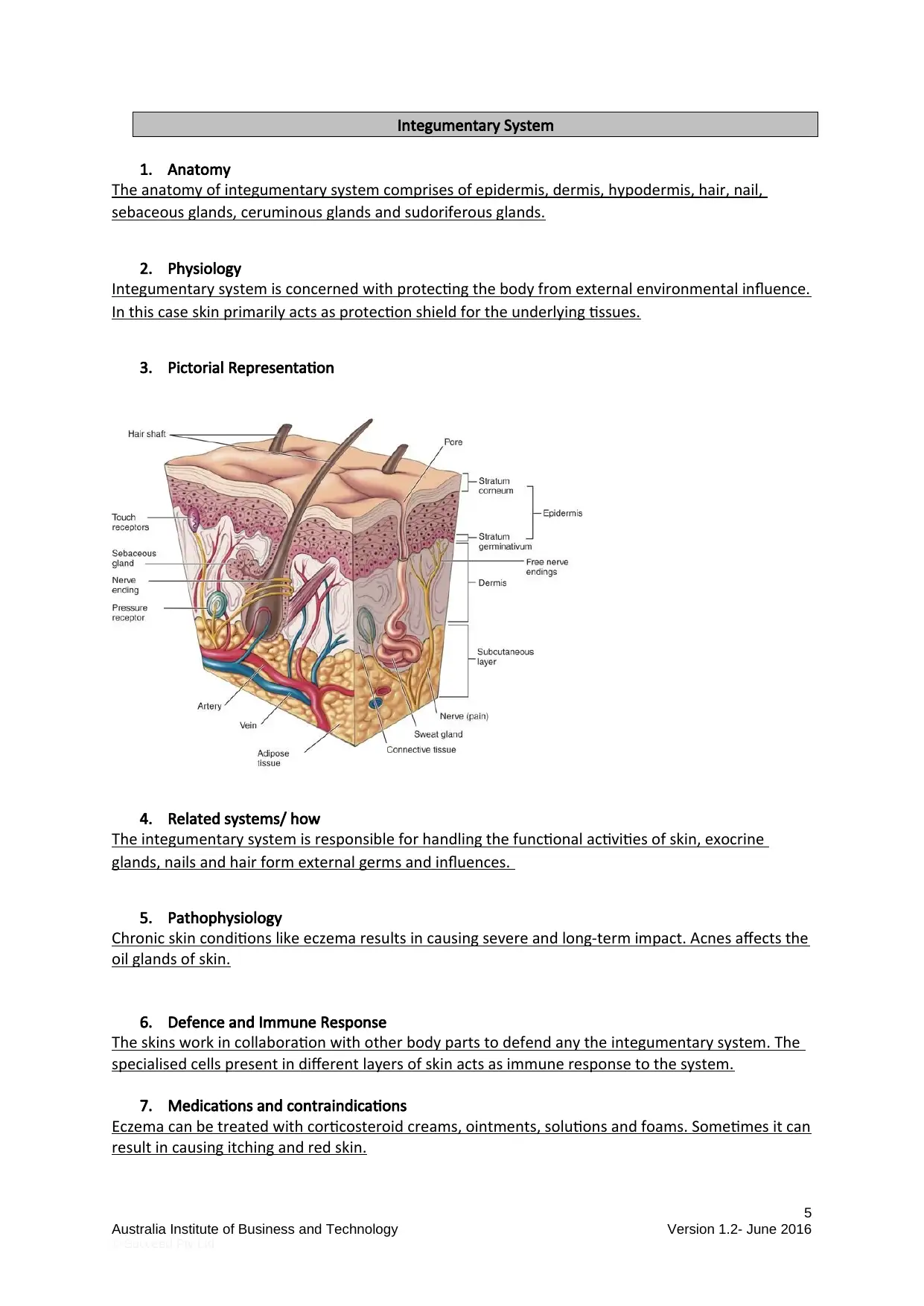
Integumentary System
1. Anatomy
The anatomy of integumentary system comprises of epidermis, dermis, hypodermis, hair, nail,
sebaceous glands, ceruminous glands and sudoriferous glands.
2. Physiology
Integumentary system is concerned with protecting the body from external environmental influence.
In this case skin primarily acts as protection shield for the underlying tissues.
3. Pictorial Representation
4. Related systems/ how
The integumentary system is responsible for handling the functional activities of skin, exocrine
glands, nails and hair form external germs and influences.
5. Pathophysiology
Chronic skin conditions like eczema results in causing severe and long-term impact. Acnes affects the
oil glands of skin.
6. Defence and Immune Response
The skins work in collaboration with other body parts to defend any the integumentary system. The
specialised cells present in different layers of skin acts as immune response to the system.
7. Medications and contraindications
Eczema can be treated with corticosteroid creams, ointments, solutions and foams. Sometimes it can
result in causing itching and red skin.
5
Australia Institute of Business and Technology Version 1.2- June 2016
© Succeed Pty Ltd
1. Anatomy
The anatomy of integumentary system comprises of epidermis, dermis, hypodermis, hair, nail,
sebaceous glands, ceruminous glands and sudoriferous glands.
2. Physiology
Integumentary system is concerned with protecting the body from external environmental influence.
In this case skin primarily acts as protection shield for the underlying tissues.
3. Pictorial Representation
4. Related systems/ how
The integumentary system is responsible for handling the functional activities of skin, exocrine
glands, nails and hair form external germs and influences.
5. Pathophysiology
Chronic skin conditions like eczema results in causing severe and long-term impact. Acnes affects the
oil glands of skin.
6. Defence and Immune Response
The skins work in collaboration with other body parts to defend any the integumentary system. The
specialised cells present in different layers of skin acts as immune response to the system.
7. Medications and contraindications
Eczema can be treated with corticosteroid creams, ointments, solutions and foams. Sometimes it can
result in causing itching and red skin.
5
Australia Institute of Business and Technology Version 1.2- June 2016
© Succeed Pty Ltd
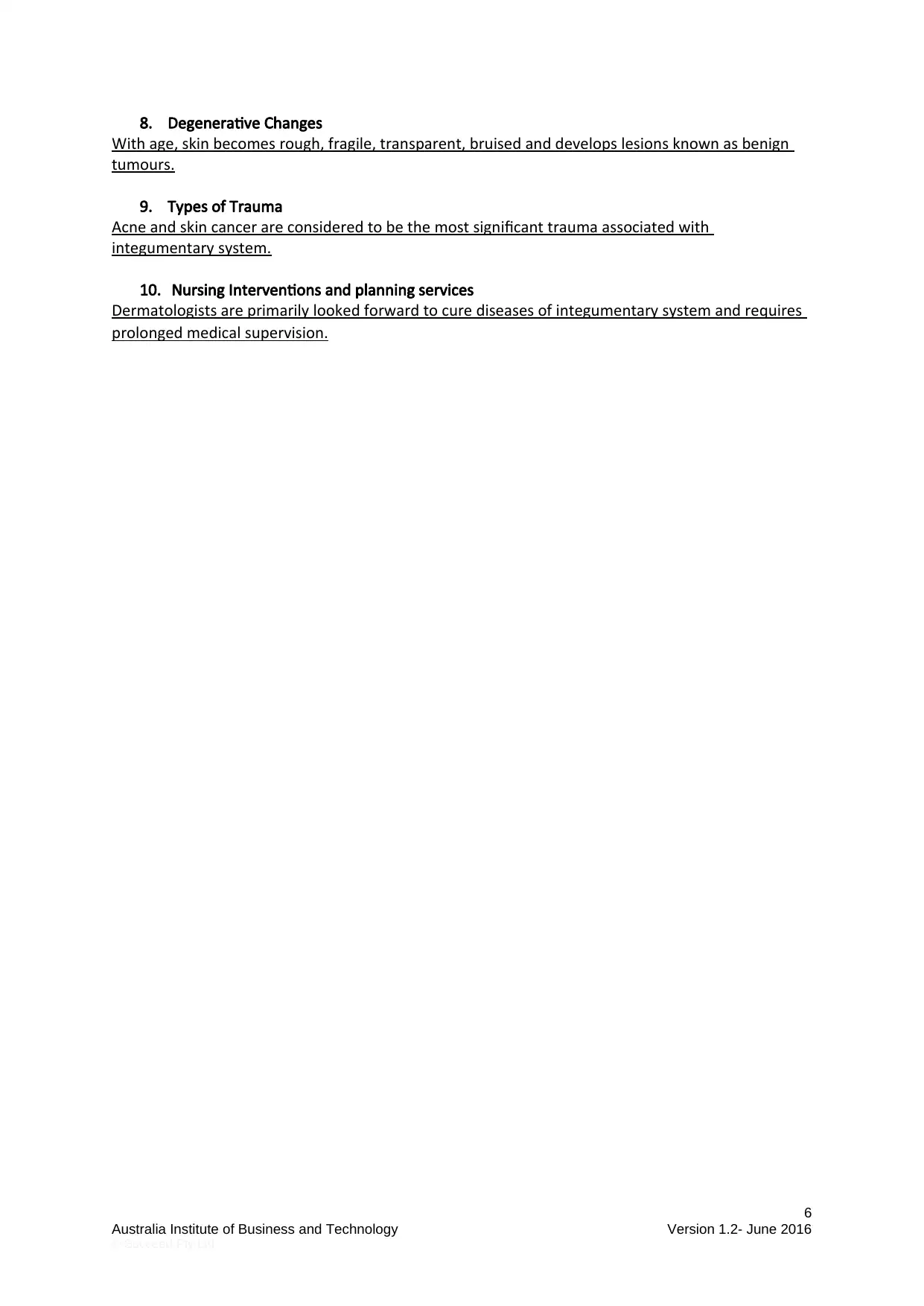
8. Degenerative Changes
With age, skin becomes rough, fragile, transparent, bruised and develops lesions known as benign
tumours.
9. Types of Trauma
Acne and skin cancer are considered to be the most significant trauma associated with
integumentary system.
10. Nursing Interventions and planning services
Dermatologists are primarily looked forward to cure diseases of integumentary system and requires
prolonged medical supervision.
6
Australia Institute of Business and Technology Version 1.2- June 2016
© Succeed Pty Ltd
With age, skin becomes rough, fragile, transparent, bruised and develops lesions known as benign
tumours.
9. Types of Trauma
Acne and skin cancer are considered to be the most significant trauma associated with
integumentary system.
10. Nursing Interventions and planning services
Dermatologists are primarily looked forward to cure diseases of integumentary system and requires
prolonged medical supervision.
6
Australia Institute of Business and Technology Version 1.2- June 2016
© Succeed Pty Ltd
⊘ This is a preview!⊘
Do you want full access?
Subscribe today to unlock all pages.

Trusted by 1+ million students worldwide
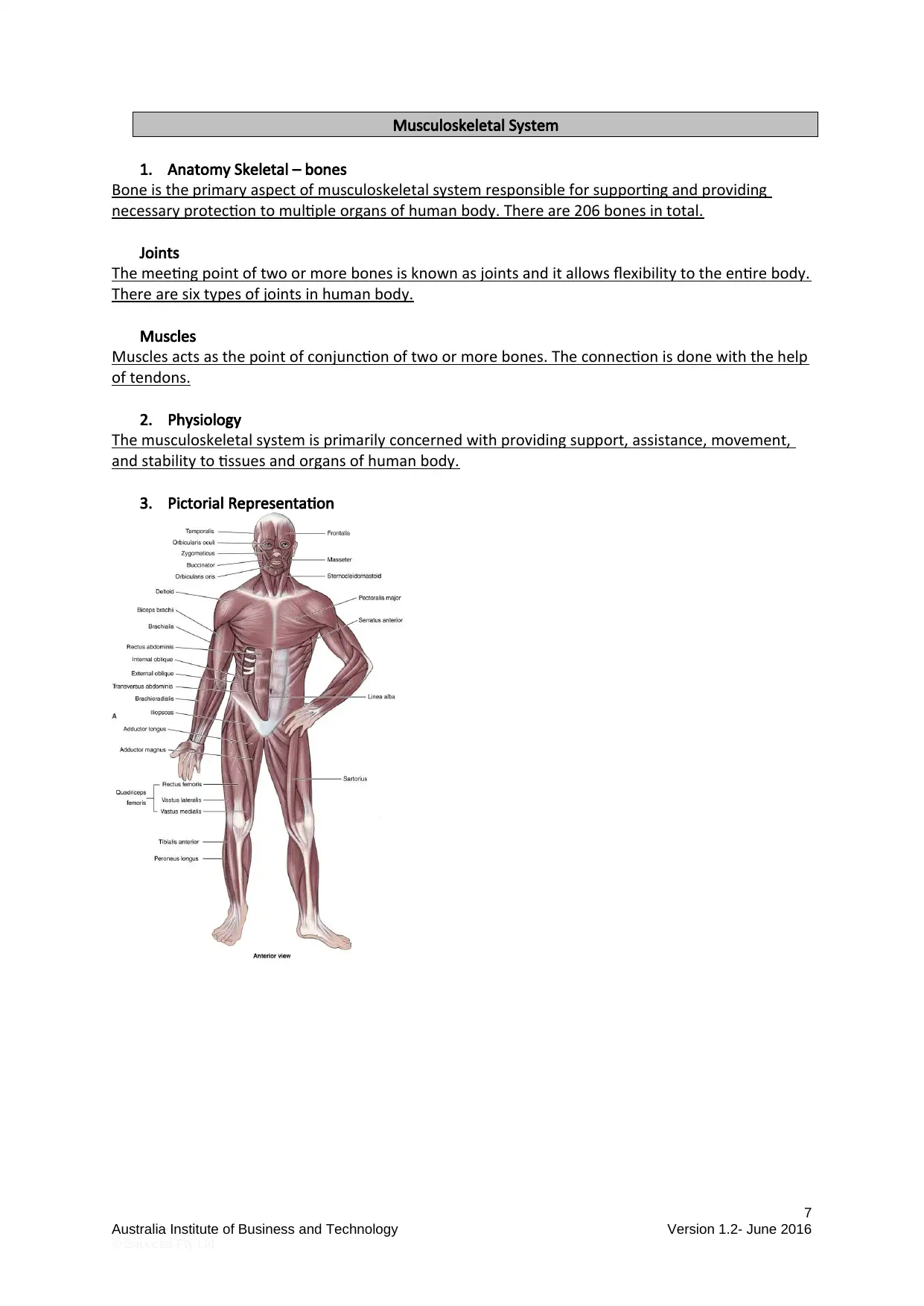
Musculoskeletal System
1. Anatomy Skeletal – bones
Bone is the primary aspect of musculoskeletal system responsible for supporting and providing
necessary protection to multiple organs of human body. There are 206 bones in total.
Joints
The meeting point of two or more bones is known as joints and it allows flexibility to the entire body.
There are six types of joints in human body.
Muscles
Muscles acts as the point of conjunction of two or more bones. The connection is done with the help
of tendons.
2. Physiology
The musculoskeletal system is primarily concerned with providing support, assistance, movement,
and stability to tissues and organs of human body.
3. Pictorial Representation
7
Australia Institute of Business and Technology Version 1.2- June 2016
© Succeed Pty Ltd
1. Anatomy Skeletal – bones
Bone is the primary aspect of musculoskeletal system responsible for supporting and providing
necessary protection to multiple organs of human body. There are 206 bones in total.
Joints
The meeting point of two or more bones is known as joints and it allows flexibility to the entire body.
There are six types of joints in human body.
Muscles
Muscles acts as the point of conjunction of two or more bones. The connection is done with the help
of tendons.
2. Physiology
The musculoskeletal system is primarily concerned with providing support, assistance, movement,
and stability to tissues and organs of human body.
3. Pictorial Representation
7
Australia Institute of Business and Technology Version 1.2- June 2016
© Succeed Pty Ltd
Paraphrase This Document
Need a fresh take? Get an instant paraphrase of this document with our AI Paraphraser
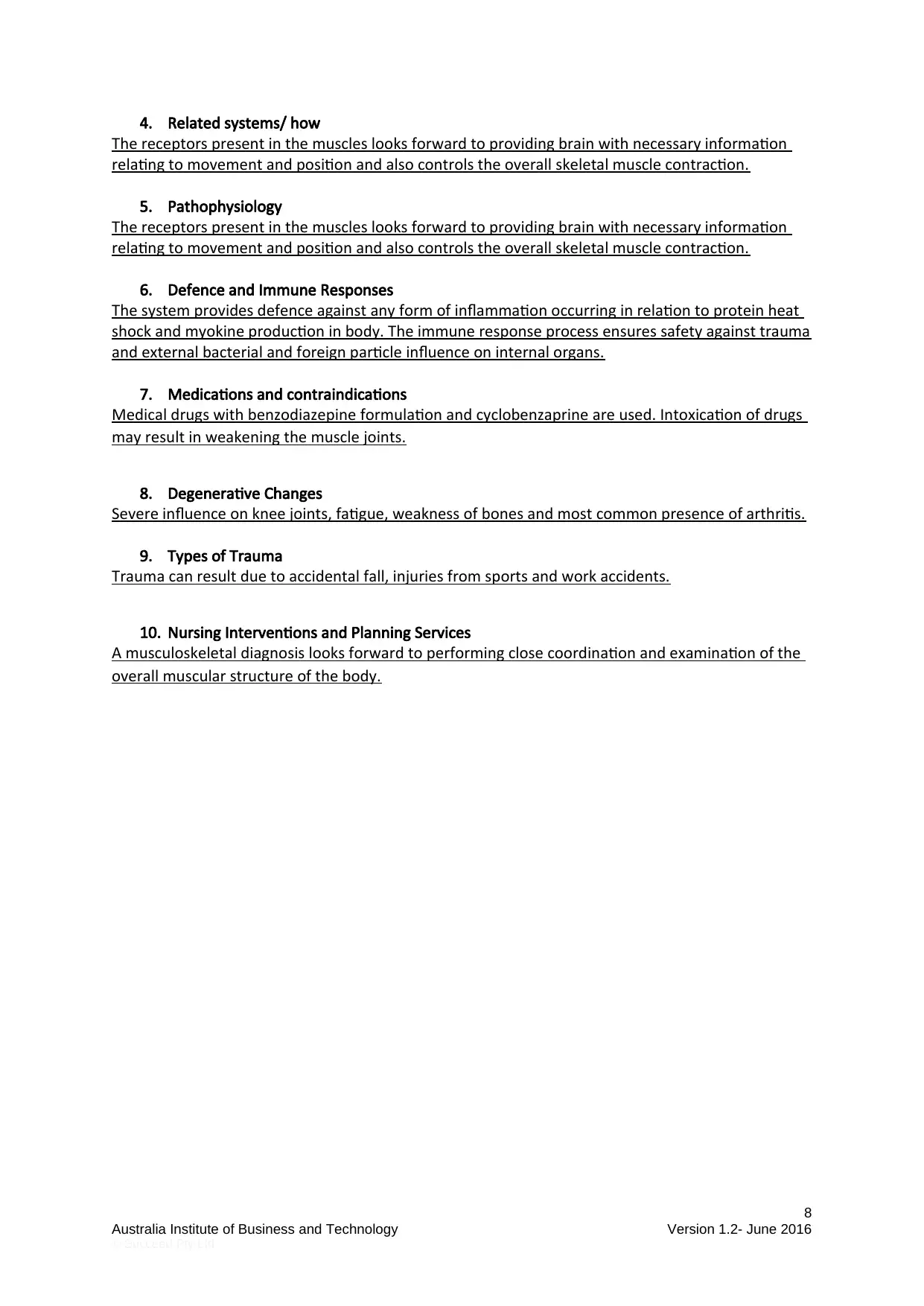
4. Related systems/ how
The receptors present in the muscles looks forward to providing brain with necessary information
relating to movement and position and also controls the overall skeletal muscle contraction.
5. Pathophysiology
The receptors present in the muscles looks forward to providing brain with necessary information
relating to movement and position and also controls the overall skeletal muscle contraction.
6. Defence and Immune Responses
The system provides defence against any form of inflammation occurring in relation to protein heat
shock and myokine production in body. The immune response process ensures safety against trauma
and external bacterial and foreign particle influence on internal organs.
7. Medications and contraindications
Medical drugs with benzodiazepine formulation and cyclobenzaprine are used. Intoxication of drugs
may result in weakening the muscle joints.
8. Degenerative Changes
Severe influence on knee joints, fatigue, weakness of bones and most common presence of arthritis.
9. Types of Trauma
Trauma can result due to accidental fall, injuries from sports and work accidents.
10. Nursing Interventions and Planning Services
A musculoskeletal diagnosis looks forward to performing close coordination and examination of the
overall muscular structure of the body.
8
Australia Institute of Business and Technology Version 1.2- June 2016
© Succeed Pty Ltd
The receptors present in the muscles looks forward to providing brain with necessary information
relating to movement and position and also controls the overall skeletal muscle contraction.
5. Pathophysiology
The receptors present in the muscles looks forward to providing brain with necessary information
relating to movement and position and also controls the overall skeletal muscle contraction.
6. Defence and Immune Responses
The system provides defence against any form of inflammation occurring in relation to protein heat
shock and myokine production in body. The immune response process ensures safety against trauma
and external bacterial and foreign particle influence on internal organs.
7. Medications and contraindications
Medical drugs with benzodiazepine formulation and cyclobenzaprine are used. Intoxication of drugs
may result in weakening the muscle joints.
8. Degenerative Changes
Severe influence on knee joints, fatigue, weakness of bones and most common presence of arthritis.
9. Types of Trauma
Trauma can result due to accidental fall, injuries from sports and work accidents.
10. Nursing Interventions and Planning Services
A musculoskeletal diagnosis looks forward to performing close coordination and examination of the
overall muscular structure of the body.
8
Australia Institute of Business and Technology Version 1.2- June 2016
© Succeed Pty Ltd
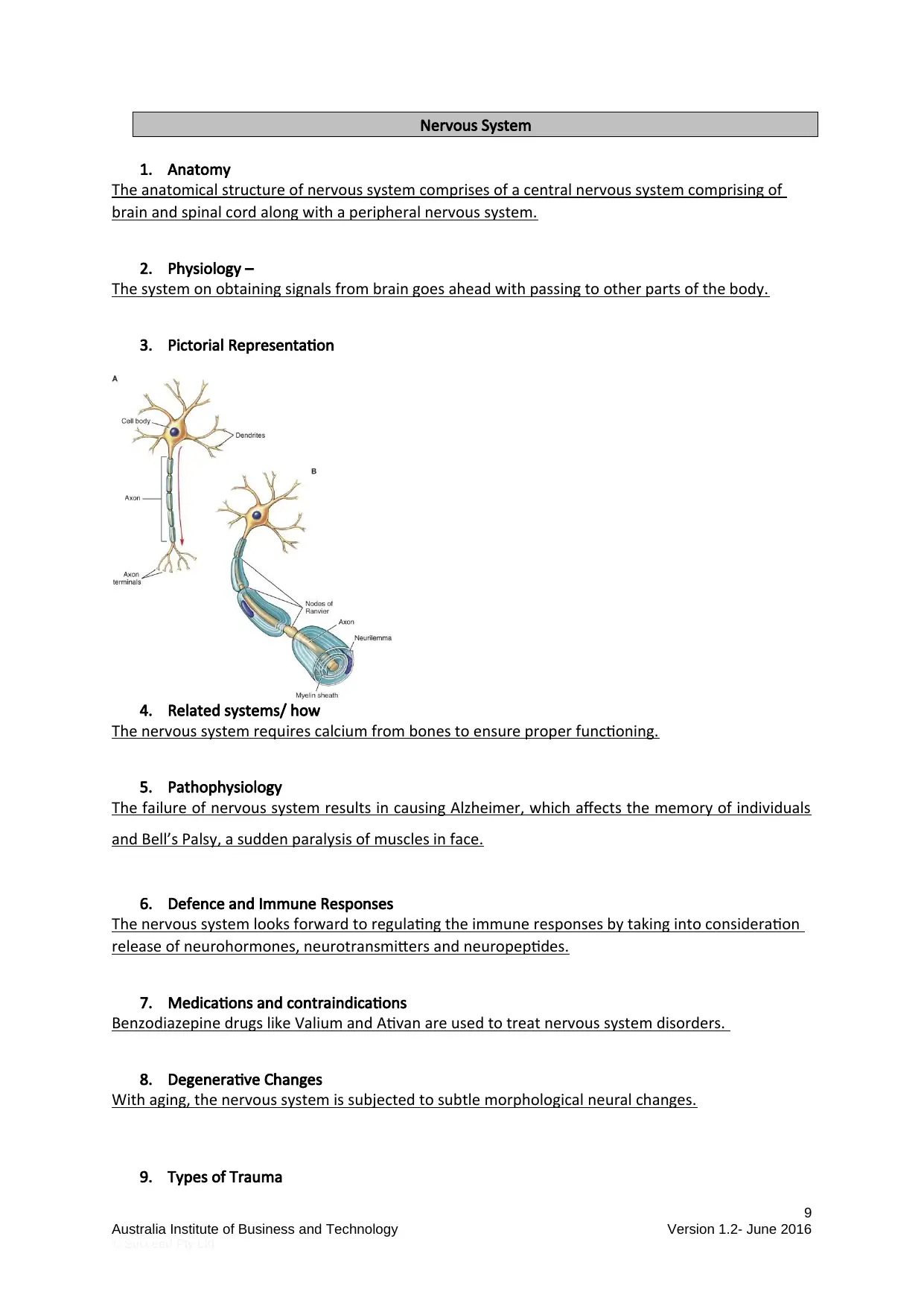
Nervous System
1. Anatomy
The anatomical structure of nervous system comprises of a central nervous system comprising of
brain and spinal cord along with a peripheral nervous system.
2. Physiology –
The system on obtaining signals from brain goes ahead with passing to other parts of the body.
3. Pictorial Representation
4. Related systems/ how
The nervous system requires calcium from bones to ensure proper functioning.
5. Pathophysiology
The failure of nervous system results in causing Alzheimer, which affects the memory of individuals
and Bell’s Palsy, a sudden paralysis of muscles in face.
6. Defence and Immune Responses
The nervous system looks forward to regulating the immune responses by taking into consideration
release of neurohormones, neurotransmitters and neuropeptides.
7. Medications and contraindications
Benzodiazepine drugs like Valium and Ativan are used to treat nervous system disorders.
8. Degenerative Changes
With aging, the nervous system is subjected to subtle morphological neural changes.
9. Types of Trauma
9
Australia Institute of Business and Technology Version 1.2- June 2016
© Succeed Pty Ltd
1. Anatomy
The anatomical structure of nervous system comprises of a central nervous system comprising of
brain and spinal cord along with a peripheral nervous system.
2. Physiology –
The system on obtaining signals from brain goes ahead with passing to other parts of the body.
3. Pictorial Representation
4. Related systems/ how
The nervous system requires calcium from bones to ensure proper functioning.
5. Pathophysiology
The failure of nervous system results in causing Alzheimer, which affects the memory of individuals
and Bell’s Palsy, a sudden paralysis of muscles in face.
6. Defence and Immune Responses
The nervous system looks forward to regulating the immune responses by taking into consideration
release of neurohormones, neurotransmitters and neuropeptides.
7. Medications and contraindications
Benzodiazepine drugs like Valium and Ativan are used to treat nervous system disorders.
8. Degenerative Changes
With aging, the nervous system is subjected to subtle morphological neural changes.
9. Types of Trauma
9
Australia Institute of Business and Technology Version 1.2- June 2016
© Succeed Pty Ltd
⊘ This is a preview!⊘
Do you want full access?
Subscribe today to unlock all pages.

Trusted by 1+ million students worldwide
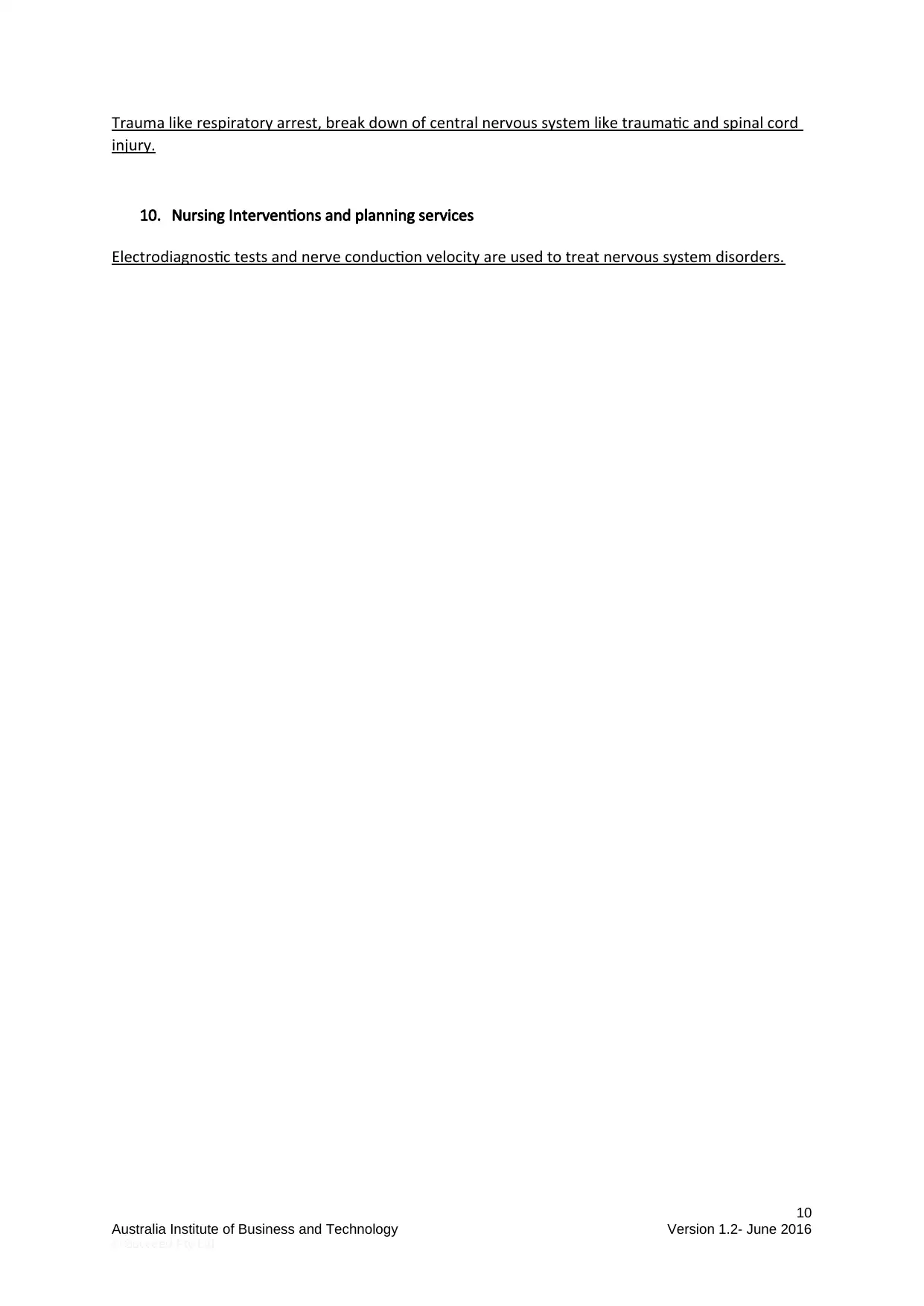
Trauma like respiratory arrest, break down of central nervous system like traumatic and spinal cord
injury.
10. Nursing Interventions and planning services
Electrodiagnostic tests and nerve conduction velocity are used to treat nervous system disorders.
10
Australia Institute of Business and Technology Version 1.2- June 2016
© Succeed Pty Ltd
injury.
10. Nursing Interventions and planning services
Electrodiagnostic tests and nerve conduction velocity are used to treat nervous system disorders.
10
Australia Institute of Business and Technology Version 1.2- June 2016
© Succeed Pty Ltd
Paraphrase This Document
Need a fresh take? Get an instant paraphrase of this document with our AI Paraphraser
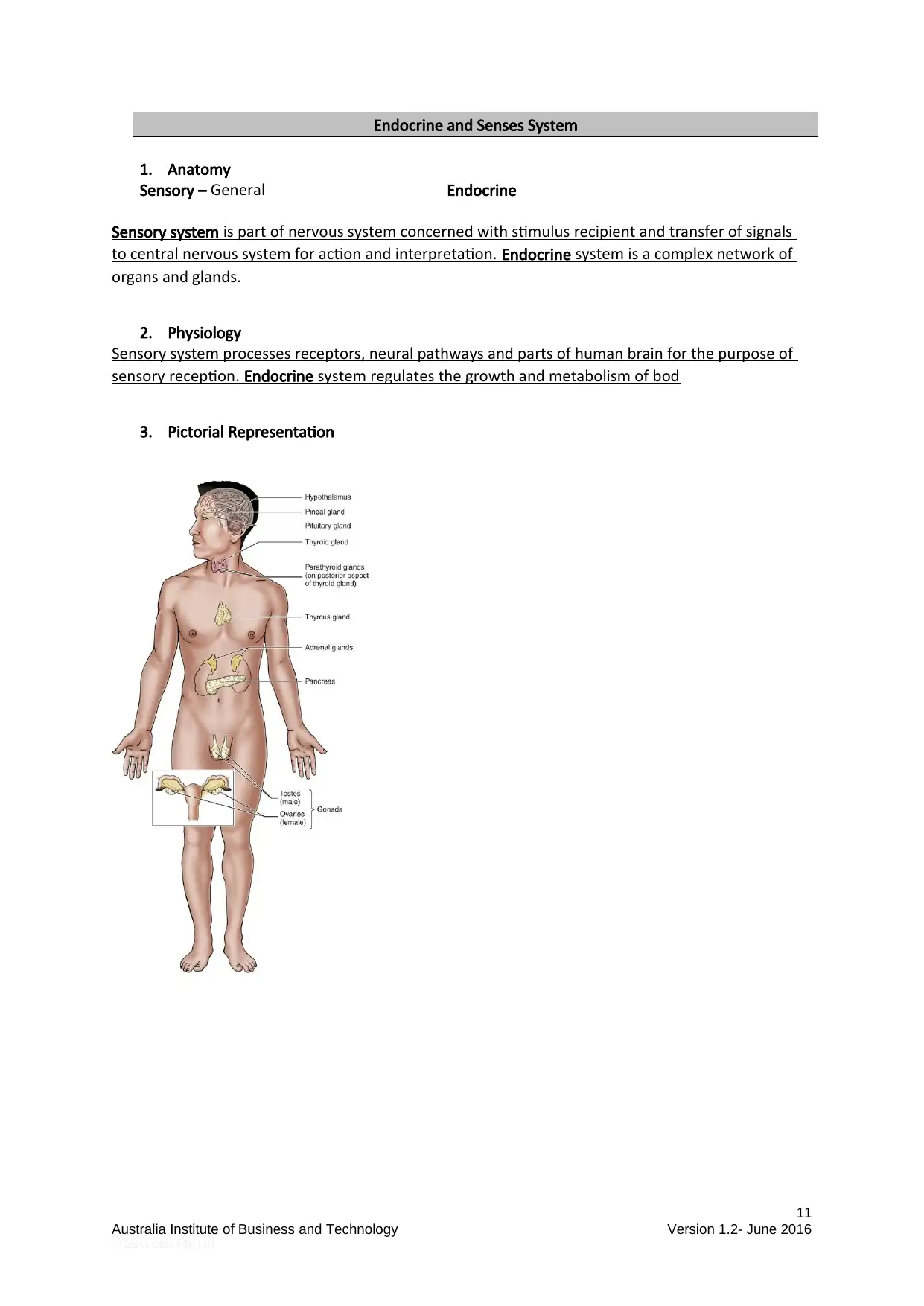
Endocrine and Senses System
1. Anatomy
Sensory – General Endocrine
Sensory system is part of nervous system concerned with stimulus recipient and transfer of signals
to central nervous system for action and interpretation. Endocrine system is a complex network of
organs and glands.
2. Physiology
Sensory system processes receptors, neural pathways and parts of human brain for the purpose of
sensory reception. Endocrine system regulates the growth and metabolism of bod
3. Pictorial Representation
11
Australia Institute of Business and Technology Version 1.2- June 2016
© Succeed Pty Ltd
1. Anatomy
Sensory – General Endocrine
Sensory system is part of nervous system concerned with stimulus recipient and transfer of signals
to central nervous system for action and interpretation. Endocrine system is a complex network of
organs and glands.
2. Physiology
Sensory system processes receptors, neural pathways and parts of human brain for the purpose of
sensory reception. Endocrine system regulates the growth and metabolism of bod
3. Pictorial Representation
11
Australia Institute of Business and Technology Version 1.2- June 2016
© Succeed Pty Ltd
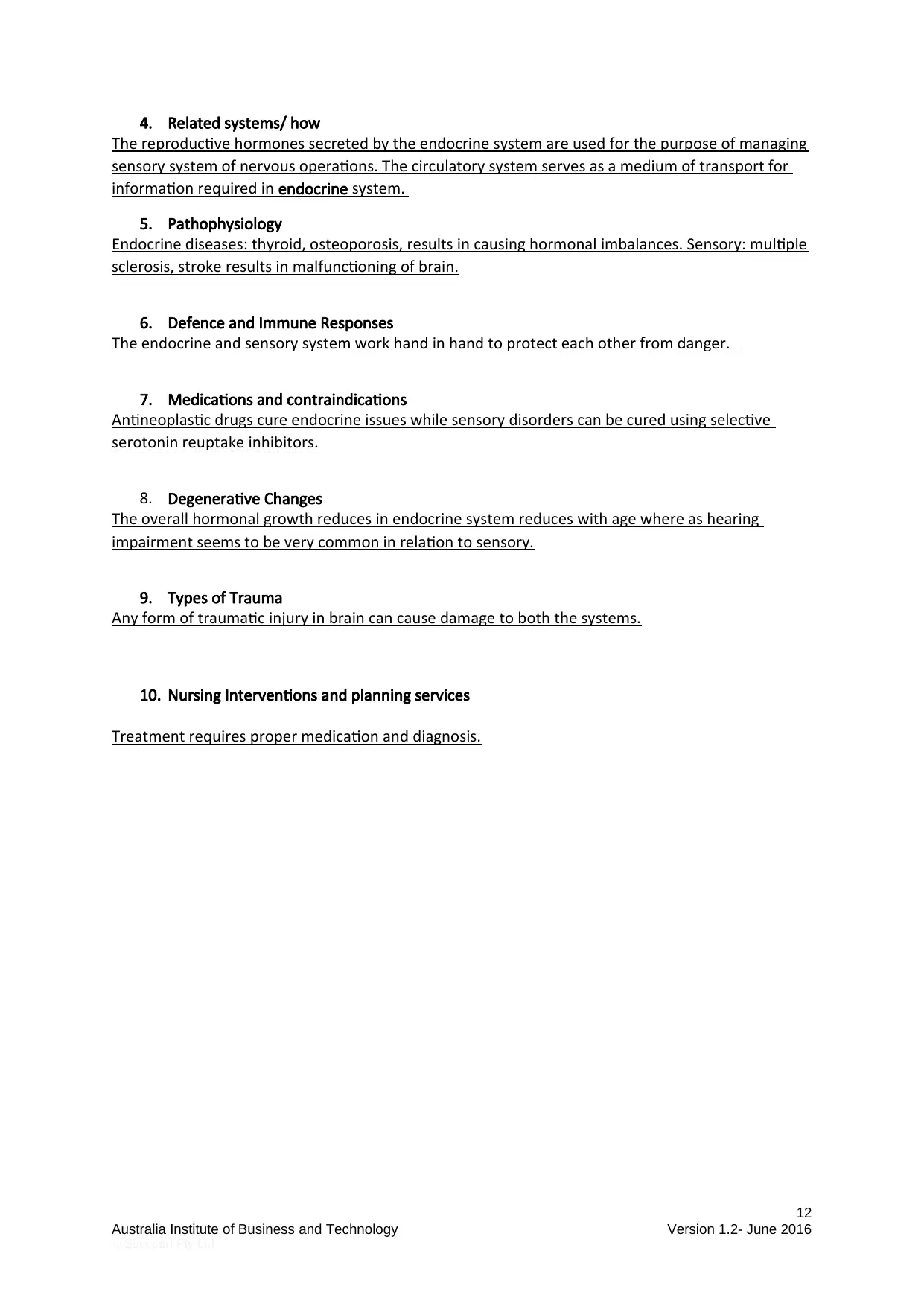
4. Related systems/ how
The reproductive hormones secreted by the endocrine system are used for the purpose of managing
sensory system of nervous operations. The circulatory system serves as a medium of transport for
information required in endocrine system.
5. Pathophysiology
Endocrine diseases: thyroid, osteoporosis, results in causing hormonal imbalances. Sensory: multiple
sclerosis, stroke results in malfunctioning of brain.
6. Defence and Immune Responses
The endocrine and sensory system work hand in hand to protect each other from danger.
7. Medications and contraindications
Antineoplastic drugs cure endocrine issues while sensory disorders can be cured using selective
serotonin reuptake inhibitors.
8. Degenerative Changes
The overall hormonal growth reduces in endocrine system reduces with age where as hearing
impairment seems to be very common in relation to sensory.
9. Types of Trauma
Any form of traumatic injury in brain can cause damage to both the systems.
10. Nursing Interventions and planning services
Treatment requires proper medication and diagnosis.
12
Australia Institute of Business and Technology Version 1.2- June 2016
© Succeed Pty Ltd
The reproductive hormones secreted by the endocrine system are used for the purpose of managing
sensory system of nervous operations. The circulatory system serves as a medium of transport for
information required in endocrine system.
5. Pathophysiology
Endocrine diseases: thyroid, osteoporosis, results in causing hormonal imbalances. Sensory: multiple
sclerosis, stroke results in malfunctioning of brain.
6. Defence and Immune Responses
The endocrine and sensory system work hand in hand to protect each other from danger.
7. Medications and contraindications
Antineoplastic drugs cure endocrine issues while sensory disorders can be cured using selective
serotonin reuptake inhibitors.
8. Degenerative Changes
The overall hormonal growth reduces in endocrine system reduces with age where as hearing
impairment seems to be very common in relation to sensory.
9. Types of Trauma
Any form of traumatic injury in brain can cause damage to both the systems.
10. Nursing Interventions and planning services
Treatment requires proper medication and diagnosis.
12
Australia Institute of Business and Technology Version 1.2- June 2016
© Succeed Pty Ltd
⊘ This is a preview!⊘
Do you want full access?
Subscribe today to unlock all pages.

Trusted by 1+ million students worldwide
1 out of 23
Related Documents
Your All-in-One AI-Powered Toolkit for Academic Success.
+13062052269
info@desklib.com
Available 24*7 on WhatsApp / Email
![[object Object]](/_next/static/media/star-bottom.7253800d.svg)
Unlock your academic potential
Copyright © 2020–2025 A2Z Services. All Rights Reserved. Developed and managed by ZUCOL.





